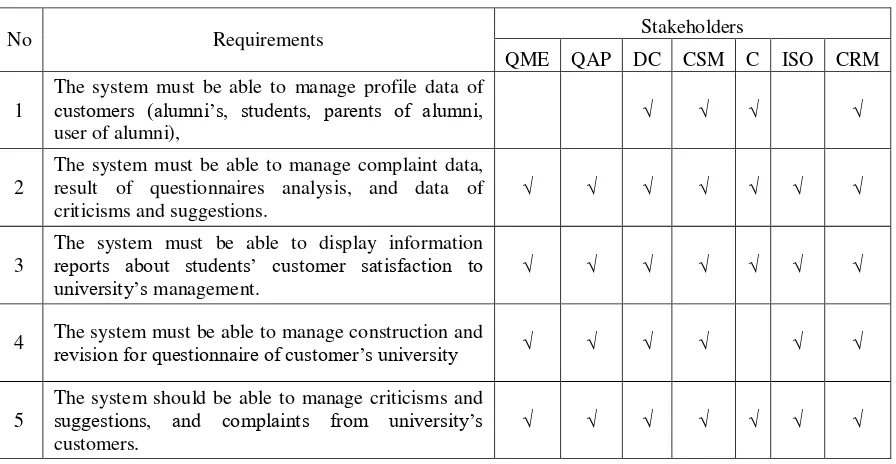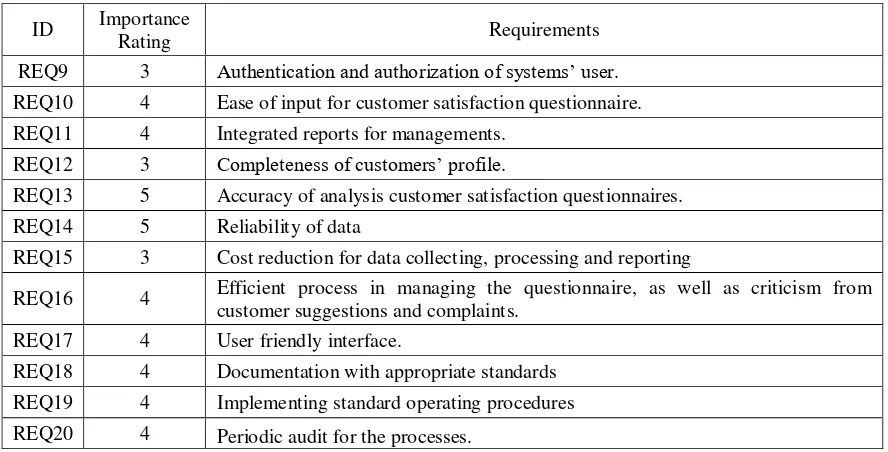ISBN 979-587-627-9 128
REQUIREMENTS ENGINEERING FOR CUSTOMER
SATISFACTION MANAGEMENT SYSTEM OF HIGHER
EDUCATION IMPLEMENTING E-CRM AND ISO 9001:2008
Mgs. Afriyan Firdaus1)
InformationSystem Department, Faculty of Computer Science, Sriwijaya University
ABSTRACT
In developing optimum management system for customer satisfaction, a vital component that needs to be emphasized is system’s requirements engineering. This study focus on system’s requirements engineering for customer satisfaction management systems that adopt quality management system with international standards ISO 9001: 2008 and E-CRM. Requirement Engineering processes that is conducted in this paper including elicitation, analysis, validation, negotiation, documentation and management. The result is eight functional and twelve non-functional requirements that will establish an optimum management system for customer satisfaction.
Keywords : requirements engineering, management system, customer satisfaction, ISO 9001: 2008, E-CRM.
INTRODUCTION
Based on learning executives survey of 2004 Accenture Learning (in Aubert, 2007), increasing customer satisfaction is one of the focus that is pursued by educational institutions in addition to increased revenue and competitive differentiation.Education system, especially higher education system, in an attempt to react to the increasing demands and pressure from stakeholders, stand in environment that is market-oriented, with internal and external customers, where, "satisfying customers" is the rule of survival in the long term, need to identify and apply relevant concepts of total quality management for each and every aspect of academic life; namely, to teaching, learning and administrative activity (Sahney, Banwet, & Karunes, 2004).
Since Quality Management System ISO 9001 fourth revision in 2008 (ISO 9001: 2008) focuses on the implementation of customer satisfaction (Liao, 2011), Higher education institutions apply ISO 9001 standards in order to improve internal processes and institutional procedures for ISO 9001 to compete in the market
ISBN 979-587-627-9 129
On the other hand, customer satisfaction is one of the most important goals of the Electronic Customer Relationship Management (e-CRM) (Moezzi, Nawaser, Shakhsian, & Khani, 2012). According to Grant and Anderson, in (Seeman & O'Hara, 2006), From the perspective of "student as customer", the educationalCRM system will provide students administrative process in general - reception, registration, financialadministration, etc. - through a single system that will facilitate complete understanding of the uniqueness of each student. Meanwhile, from the perspective of "alumni as customer", a CRM system can provide a good service to alumni’susers and can accommodate their feedback to harmonize their needs with the learning process in college (Firdaus, Rifai, Putra, Vanhar, &Indah, 2012).
In developing optimum management system for customer satisfaction, a vital component that needs to be emphasized is system’s requirements engineering. These activities include the systematic process of exploring, understanding, analyzing, documenting and managing the system requirements. The role of system’s requirements engineering can be linked to the business goals, such as improving user satisfaction by providing workingproducts, reducing marketingtime of products, adjust cost, schedule and quality objectives and using human resources more effective (Young, 2003).
Based on the backgroundabove, thispaper emphasize on improving customer satisfaction in higher education, especially students and alumni’s users by combining the concepts of quality management system with ISO 9001: 2008 and the concept of E-CRM. This study will focus on system’s requirements engineering for customer satisfaction management systems that adopt quality management system with international standards ISO 9001: 2008 and E-CRM.
REQUIREMENT ENGINEERING PROCESSES
Some activities that are fundamental to all requirement engineering processes that is adopted from Sommerville (2005) in this paper (illustrated on Figure 1) including:
1. Elicitation. This activity focuses on identifying sources of information about the system and discovering the requirements from these.
2. Analysis. This activity focuses on understanding the requirements, their overlaps, and their conflicts.
3. Validation.This activity focuses on going back to the system stakeholders and checking if the requirements are what they really need.
4. Negotiation.This activity focuses on trying to reconcile conflicting stakeholders’ views and generating a consistent set of requirements.
5. Documentation. This activity focuses on writing down the requirements in a way that stakeholders and software developers can understand.
ISBN 979-587-627-9 130
Figure 1 The Requirements Engineering Activity Cycle (Sommerville, 2005)
RESULTS AND FINDINGS
REQUIREMENTS ELICITATION
In this paper, Requirement elicitation implements traditional requirements elicitation processes (TREPS) introduced by Katina, Keating, Jaradat (2014) to identify sources of information about the customer satisfaction system and discovering the requirements by interviewing higher education expert in quality management, quality assurance personnel in university, ISO document control personnel in university and customer satisfaction manager in university. Moreover, another activity that is done was reading existing documents about current system and concept of ISO 9001:2008 quality management system and electronic customer management system (E-CRM).The requirements elicitation result showed in Table 1.
Table 1 Requirements Elicitation Results
No Requirements Stakeholders
QME QAP DC CSM C ISO CRM
1
The system must be able to manage profile data of customers (alumni’s, students, parents of alumni, user of alumni),
√ √ √
√
2
The system must be able to manage complaint data, result of questionnaires analysis, and data of criticisms and suggestions.
√ √ √ √ √ √ √
3
The system must be able to display information reports about students’ customer satisfaction to
university’s management. √ √ √ √ √ √ √
4 The system must be able to manage construction and revision for questionnaire of customer’s university √ √ √ √
√ √
5
The system should be able to manage criticisms and suggestions, and complaints from university’s customers.
ISBN 979-587-627-9 131
No Requirements Stakeholders
QME QAP DC CSM C ISO CRM
6
The system should provide convenience in the delivery of criticisms and suggestions and complaints by providing online web-based system for customers.
tailored to specific criticisms and suggestions.
√ √ √ √ √ customers’ questionnaires to monitor the level of customer satisfaction.
√ √ √ √ √ √ √
15
The system should be able to prepare reports that are integrated into the system and provide evaluation in order to improve quality.
√ √ √ √ √ √ √
16
The system developed is expected to shorten the time of work especially in terms of customer satisfaction
The system should reduce the cost of telephone, fax, the use of paper in the form of questionnaires and a form of customer satisfaction complaint.
√ √ √ √ √ √ √
25 The system should provide periodic audit for the
processes. √ √ √ √ √
Legends:
QME : Quality Managemenr Expert QAP : Quality Assurance Personnel
DC : Document Control
ISBN 979-587-627-9 132
C : Customer (alumni / students / parents of alumni / user of alumni)
ISO : ISO 9001:2008 concept
CRM : Customer Relationship Management concept
REQUIREMENTS ANALYSIS, VALIDATION AND NEGOTIATION
In this process, the requirements obtained in requirements elicitation are identified related to their appropriateness, completeness, quality, and value. The requirements analysis using requirements enumeration and continued by validation process by stakeholders related to system to convince that artifacts satisfy established criteria and standards, defined process. All validated requirements then negotiated to steering committee consist of system owner and two quality managements personnel in university. The results are validated enumerated functional requirements and validated enumerated non-functional requirements. Validated enumerated functional requirements (showed in Table 2) show eight validated requirements related to function,activities and services a system must provide, requirement ID and importance rating for the requirements.
Table 2 Validated Enumerated Functional Requirements
ID Importance
Rating Requirements
REQ1 4 The system shall manage profile data of customers (alumni’s, students, parents of
alumni, user of alumni),
REQ2 3 The system shall manage registration and validation of registration for the
customers.
REQ3 5 The system shall manage data of complaints, criticisms and suggestions from
customers,
REQ4 3 The system shall response to customers’ criticisms, suggestions and complaints.
REQ5 4 The system shall monitor the level of customer satisfaction.
REQ6 5 The system shall analyze the result of customers’ questionnaires,
REQ7 5 The system shall manage construction and revision of questionnaires
REQ8 5 The system shall report information about customers’ criticisms, suggestions and
complaints;
ISBN 979-587-627-9 133
Table 3 Validated Enumerated Non-Functional Requirements
ID Importance
Rating Requirements
REQ9 3 Authentication and authorization of systems’ user.
REQ10 4 Ease of input for customer satisfaction questionnaire.
REQ11 4 Integrated reports for managements.
REQ12 3 Completeness of customers’ profile.
REQ13 5 Accuracy of analysis customer satisfaction questionnaires.
REQ14 5 Reliability of data
REQ15 3 Cost reduction for data collecting, processing and reporting
REQ16 4 Efficient process in managing the questionnaire, as well as criticism from
customer suggestions and complaints.
REQ17 4 User friendly interface.
REQ18 4 Documentation with appropriate standards
REQ19 4 Implementing standard operating procedures
REQ20 4 Periodic audit for the processes.
REQUIREMENTS DOCUMENTATION AND MANAGEMENT
These processes consist of documentation and management processes to document and manage the requirement resulted from requirements analysis, validation and negotiation. As this paper discussed system using ISO 9001:2008, so the requirements is documented and managed using the ISO 9001:2008 standard that will be audited periodically. The requirements will be used for system and software engineering process for optimum management system of customer satisfaction.
CONCLUSION
This paper presented requirements engineering processes for customer satisfaction management systems that adopt quality management system with international standards ISO 9001: 2008 and E-CRM including activity of requirement elicitation, analysis, validation, negotiation, documentation and management.
Requirements elicitation is done by interviewing stakeholders and reading existing documents about current system and concept of ISO 9001:2008 quality management system and electronic customer management system (E-CRM) generates twenty-five requirements.
Requirements analysis, validation and negotiation using requirements enumeration, validation by practitioners and negotiation with steering committee results eight validated enumerated functional requirements and twelve validated enumerated non-functional requirements.
ISBN 979-587-627-9 134
REFERENCES
Aubert, B. (2007). Customer education: Definition, measures and effects on customer satisfaction. Grenoble Ecole de Management (France), ProQuest Dissertations Publishing.
Firdaus, M.A., Rifai, A., Putra, A., Vanhar, R., & Indah, D. (2012). Penerapan Konsep E-CRM dalam Pengembangan Sistem Penelusuran Alumni untuk Mendukung Link and Match Perguruan Tinggi dan Industri Pengguna Alumni (Studi Kasus di Fakultas Ilmu Komputer Unsri). Industrial Engineering Conference on Telecommunication (INDECT). Bandung: Fakultas Rekayasa Industri Institut Teknologi Telkom Bandung.
Kasperavičiūtė, R. (2012). Approach of Higher Education Institutions to ISO 9001
Standard: Reasons, Issues and Benefits of Implementation. Public Policy and Administration, 11(4), 672-689.
Katina, P.F. Keating, C.B. Jaradat,R.M. (2014). System requirements engineering in complex situations. Requirements Eng. 19:45–62.
Liao, R.-C. (2011). Combining ISO 9001 QMS and PZB Model to Reach Customer
Satisfaction for School’s Extension Education Organization -- An Integrated
Approach and Empirical Study in Taiwan. Combining ISO 9001 QMS and PZB Model to Reach Customer Satisfaction for School’s Extension Education Organization -- An Integrated International Journal of Digital Content Technology and its Applications, 5(6), 207-213.
Moezzi, H., Nawaser, K., Shakhsian, F., & Khani, D. (2012). Customer relationship management (e-CRM): New approach to customer’s satisfaction. African Journal of Business Management, 6(5), 2048-2055.
Sahney, S., Banwet, D., & Karunes, S. (2004). Conceptualizing total quality management in higher education. The TQM Magazine, 16(2), 145.
Seeman, E., & O'Hara, M. (2006). Customer relationship management in higher education: Using information systems to improve the student-school relationship. Campus-Wide Information Systems, 23(1), 24-34.
Sommerville, I. (2005). Integrated RequirementsEngineering: A Tutorial. IEEE Software Published by the IEEE Computer Society. January/February 2005.


